
Hiking Dude Blog
2025 - Aug Jul
2024 2023 2022 2021 2020 2019 2018 2017 2016 2015 2014 2013 2012 2011
09/08/2022
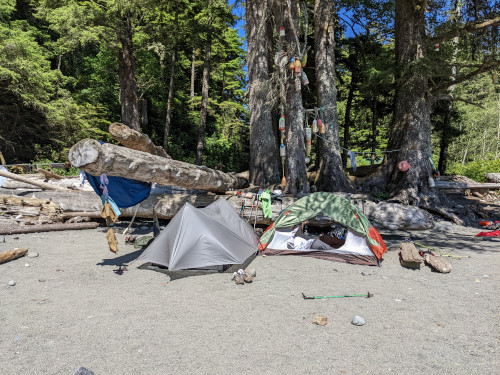
More Miles = More Smiles is typically how a long hike goes. As long as there's daylight, the feet are moving and the next beautiful view is anticipated ahead on the trail. There is very little time spent sitting around a campsite - basically make dinner and head to bed for an early start on the next day.
As I mentioned earlier, the West Coast Trail is not a typical long distance trail. At only about 50 miles, it's a bit longer than most backpacking trips, but much shorter than most long trails (which tend to be at least hundreds of miles). This means, unless you are fastpacking or trying for an FKT, you tend to have shorter hiking days and more time in camp.
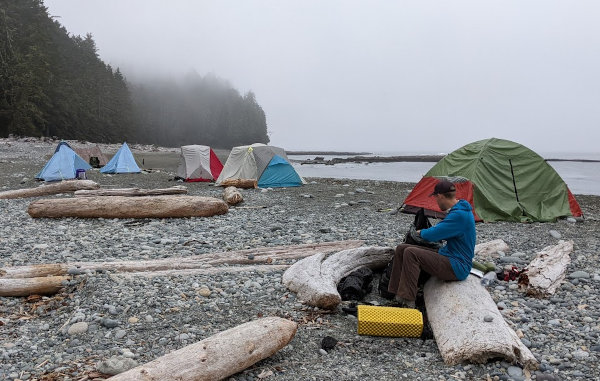
I'd like to share what our In Camp time was like on our trip, and hope it provides some insight and ideas for you planning a future West Coast Trail hike.
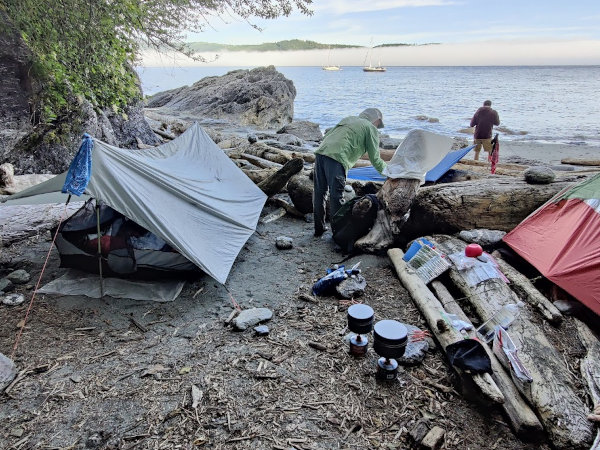
With a 5 kilometer hike from Gordon River to Thrasher Cove on our first day, even with a very late 11:15am start time after our mandatory orientation, we got to camp before 4:30pm. This would actually be our latest camp arrival time for the whole trip. Being in the 2nd group of 10 people ferried across the river, the campsite was already fairly crowded when we arrived even though we passed a few groups on the way. The photo above is of our first setup and it shows most of the important parts of our camp life.
Our Shelters - We had three different shelter styles. One person slept in a bivy sack with a silnylon tarp above him to keep off the heavy morning dew. Another two had a stand-alone tent with poles and rain fly. My wife and I had a tarp with a bug nest underneath.
All three shelters worked just fine, but a few things about them:
- the bivy takes up very little space and can be laid down between logs or rocks, or anyplace you can find.
- dome tents with poles can be pitched anywhere and really need no stakes, so sand is no problem.
- a tarp that requires separate poles needs stakes which can be a nuisance in soft sand. There were always drift logs or rocks available to help with the guylines, so it was not a problem.
- Morning dew was heavy many days. Having a rag, sponge, or bandana to sop most of the water off your shelter is a good idea.

Our Water - When I thru-hiked the Arizona Trail, finding enough water was an ongoing concern. The West Coast Trail has water everywhere! Since the trail follows the shoreline of Vancouver Island, hikers are constantly crossing small streams carrying water down from the small mountain range to the ocean. I never carried more than my single .6 liter bottle full of water, and every campsite is situated on a major river or creek.
We used two Sawyer Squeeze filters to treat all our water and they worked very well. At each camp, someone would take our three 2-liter dirty water bags to the water source, fill them, and carry them back to our campsite. Then, anyone that wanted water could attach the Squeeze filter to a bag and fill their water bottle from that. We would use the rest for dinner.
After dinner, someone would repeat the water source trip to get water for the next morning. By filling water bottles at night, while you have free time, the water can cool off more in the cold air overnight and time is saved in the morning.
Typically, we'd have a water refill and rest break once during the morning at some stream we passed. All the water sources were fine, but we were probably overly cautious at one...

At Walbran Creek, the historic water source seems to be a trickling waterfall on the east side of the creek a few hundred yards upstream from the camping area. Unfortunately, there has been a landslide there blocking access to the source. So, most people were just gathering water out of the lagoon that you can see in the background above. You can also see someone standing in the water just behind us. People were swimming, bathing, washing dishes, and I presume peeing in that water. So, we gathered all our water bottles into a large mesh bag along with our water filter and headed farther upstream. When we hit the landslide blockage, we swam across to the other side. About a quarter mile farther upstream, the lagoon ended and the stream had riffles and obvious flowage so we gathered our water there. Working our way back downstream with about 20 pounds of water over very slippery underwater rocks was quite an adventure, but at least we got good, clean water.
Also, at Tsusiat Falls camp area, I'd recommend getting water directly from the falls rather than from the outflow of the pool below it since many people bathe there. But, if no one has been in the water for some time, like early in the morning, I suppose any crud as been washed downstream.

Our Food - We really enjoyed how well our dinners worked out! We kepy things Super Simple!
Earlier this summer, on a backpacking trip in Wyoming, my buddy had made his own freeze-dried meals and they looked great. So, we purchased dried ingredients from Mother Earth Products (the best buys we could find online) and put together our own. Actually, my wife did pretty much all of it. She also purchased a tiny, inexpensive vacuum sealer and reusable bags. She added all the ingredients for one meal to a bag, closed it, and vacuumed the air out - presto! just like those $$$$ meals.
Our meals were:
- Chicken Tater Trasherole - chicken, mashed potatoes, hash browns, milk, onion, garlic, ranch dip
- Health Bowl - rice, lentils, almonds, cranberries, vegetable bouillon
- Pesto Veggie Pasta - ramen noodles, TVP, mushrooms, pesto mix, parmesan cheese, mixed vegetables
- Lentil Chili (my FAV!) - lentils, tvp, corn, peas, chili seasoning
- Adobo Chicken - chicken, rice, bouillon, garlic, pepper, soy sauce, vinegar
- Chicken Curry Rice - chicken, rice, raisins, apples, onion, curry, allspice, cinnamon, toasted nuts
The only cooking was boiling water and adding it to the individual bags.
Each person could choose which meal sounded good to them each night.
Clean up was just pouring a bit of hot water into the food bag, swishing it around, and drinking it. We took all the bags home and have washed them out to use on our next hike (we leave in a week).
We had simple non-cook food for breakfast, lunch, and snacks - cocoa, coffee, protein bars, granola bars, home-dried fruit, sausage and crackers, Austin-brand cracker sandwiches, M&Ms, trail mix, and the ever-popular Sour Patch Kids.
One super food item that I'd highly recommend is Pringles in a cardboard can (not a plastic can)! Here's why:
- Pringles are calorie dense at 150 cal/oz.
- They taste great with all that salt and crunch.
- They don't get crushed in a backpack.
- It's easy to share a can. We ate a can each day between the five of us.
- Put the lid on an empty can and squeeze the can quickly - it POPs the lid off for endless entertainment.
- The can makes an awesome garbage can when empty. You can pack wrappers and trash in it and it Will Not Break. I packed all my trash for the six days into a can and had room left.

In the photo above, you can see our cooking set up. The constant wind on the ocean meant we used wind blocks to save fuel. We had two canister stoves just so we would have boiling water for everyone at the same time - one stove would have been fine. You also might notice a Mountain House meal - one of us picked that up in a hiker box at the Crab Shack on Nitinat Narrows, so check there for free food when you hike through.
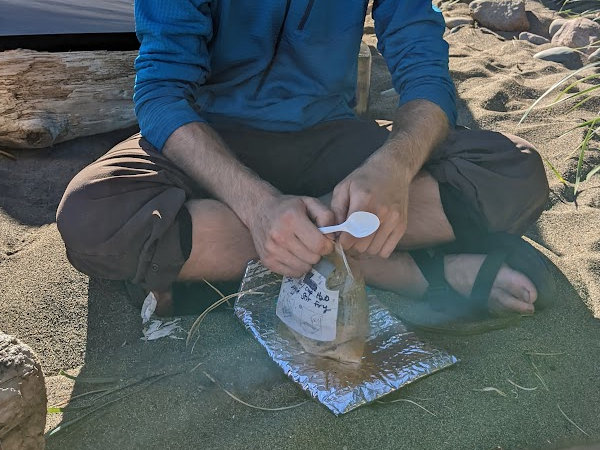
Once hot water was added to the meal pouches, we closed them and set them into individual Cozies that I made from insulating wrap. In less than 15 minutes, they were ready to eat and still very hot. These cozies are simple, cheap, and easy to make.
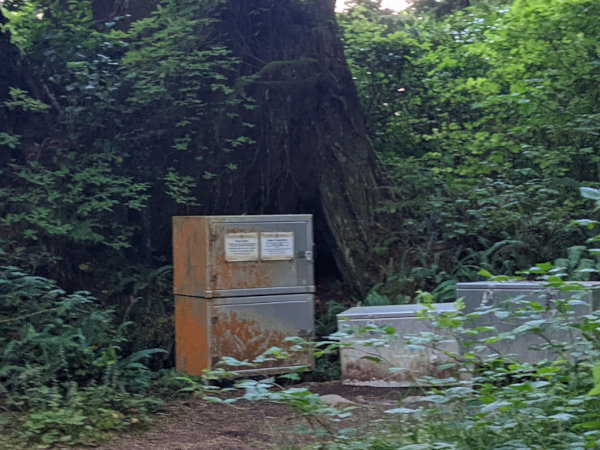
House Rules - If you are used to wild camping in the wilderness, or established camping in a park, the West Coast Trail has a few unique characteristics that puts it somewhere between the two. Reading the official paraphernalia from Parcs Canada will give you all the rules and guidelines, but some of the things I noticed were:
- Food Storage - We had a bear walk onto the beach out of the forest about 20 yards from our tent. Many other campers reported bear sightings. For this valid reason, every campsite has a group of bear containers in which campers should store their food, garbage, and smellables over night. The cans get packed full, so your crackers will probably get crushed. We also saw tracks of smaller rodents often on the beaches, and many mornings showed tiny mouse tracks completely covering every inch of wet sand in our camping area.
- Beach Camping - When you are right on the ocean's edge, things work a bit differently than inland...
- Tides - make sure your campsite is high enough that the incoming tide doesn't reach you. The high tide line is usually easy to see since the sand above it is covered with debris.
- Sand Bugs - There were no mosquitoes, flies, or ticks, but the sand is filled with tiny insects eating the washed up plant life. We got no bites from them, but maybe?
- Wet Sand - The sand at many camps is very fine and soft. When dry, it feels nice, but it gets into any crack, crevice, or open zipper. When wet, like from dew every morning, it sticks to everything. So, step carefully and wipe off lower legs and feet before going to bed and putting on shoes. And, keep things closed up and covered.
- Shelters - I mentioned before that you'll need to figure some way to anchor your tent using rocks or driftwood.
- Night Life - There are dozens of people packed into small sections of beach every night so courtesy is important.
- Campfires - I'm not used to having campfires, but there were a handful up and down the beach. Most areas were denuded of small driftwood for fires and people walked a long distance to scavenge wood. The brochures instructed to keep fires below the high tide line, but that rarely happened. Some beaches were covered in chunks of blackened wood and coal bits.
- Noise - The sounds of the ocean drown out most camper noise, but it's still nice to quiet down when the sun sets. We only had one instance of youth playing loudly next to our tents while we were trying to get to sleep and it didn't last long.
- Sleeping - I typically get up during the night when camping, but I slept straight through every night on the WCT. So, I didn't get to see any stars or night scenery. I think the soft sand makes for a very comfortable bed.
- Sewer - The guidelines say to bathe and wash dishes in the ocean or river mouths emptying into it. In other words, the ocean is the sewer out here. This is atypical to most Leave No Trace principles, but I guess dilution is a solution to pollution. Every evening, we walked down to the ocean edge to brush our teeth and spit into the waves. It was kinda fun. Fortunately, we had no dishes to wash with our meals.
- Toilets - No need to dig catholes on the West Coast Trail! The campsites have composting toilets - with yet more ladders to climb. You climb up, go inside, close the door, do your business, and then toss a handful of wood chips down the hole. That last part is important to make them work!
Since so many people all use the same door handle and ladders, washing your hands and using some alcohol sanitizer afterward is a very good idea.
It's ok to just swing by a campsite and use the toilet during the day, too.
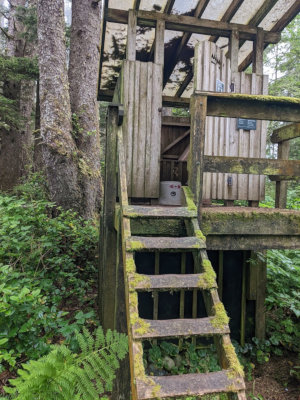

Free Time - Being 2 hours behind our normal time, we woke up pretty early and were on the trail between 6 and 7 each morning. Some of this was also because we had to match the tides to do all the beach hiking we could. This meant we arrived at most camps around 1pm with our latest time being 4:20pm. All the free time is unusual for a long distance hiker since daylight is normally used for hiking.
We got to explore pretty much all the area around the camps. The tide pools and creeks were interesting, and the view out over the ocean was always changing. We saw some whales, otters, boats, and birds.
I spent a little time carving a buoy that was found on the beach and left at Michigan Creek. I also balanced a few long logs across other logs just for something to pass the time. Setting up camp, drying clothes, making meals, and resting took up the rest of the time.
Read the day-by-day of our adventure in my West Coast Trail Journal
Posted: 09/08/2022
08/30/2022
Not long after leaving the crabshack on the ferry boat across the Nitinat Narrow to continue our northbound hike up the West Coast Trail, Kelly slipped on a very muddy uphill step. She landed right on a hiking pole and SNAP! the carbon fiber shattered.
Not long before that, I had slipped on a root and my ankle landed on my aluminum pole, bending it so it would not longer collapse. So, aluminum poles bend and fiber poles break.
Between Tsusiat Falls and Michigan Creek campsites, the West Coast Trail crosses the Kanawa River. This is a proper river with plenty of depth, width, and current - not like a little creek you can wade through. Fortunately, it also has a wonderful cable car to carry hikers across.
We sent two of us across with packs, then a 3rd with two packs, then Kelly and I with our 3 hiking poles and the last pack (and her broken one stashed away in the pack). It all went well until the very end.
This video shows our crossing...
Open video in Separate View
So, aluminum poles sink and fiber poles float.
Things like this happen all the time on the trail. We found (and carried out) broken poles, tips, and baskets, a shoe, clothing, and quite a lot of other dropped things, but very little trash like wrapper pieces on the trail. Some people might just leave the 'lost' items in the river, but that doesn't seem right and we really needed the poles to put up our tarp tent.
You can read more about our Kanawa crossing and our whole hike in my West Coast Trail Journal.
But, seriously, I prefer aluminum hiking poles over carbon fiber, and here's why:
- Aluminum is much less expensive (like $20 vs $100).
- Aluminum can take much more abuse before breaking, and has a longer lifespan of rough use.
- Bent aluminum can often be bent back to use a bit longer.
- Aluminum is not as sensitive to extreme cold and heat - especially becoming brittle in extreme cold.
- Aluminum can be recycled if the pole does become unusable.
If you decide to give hiking poles a try, take some time to learn to use them before going on a long hike. Some things to consider:
- Use the wriststrap correctly. Put your hand in from the bottom so your hand encircles both the wriststrap and the grip. This saves a lot of hand and wrist fatigue.
- Remove rubber tip guards and baskets. This reduces weight and prevents them from being lost on trail - I've lost count of the tips I've found along the way.
- Figure out your cadence between feet and poles. Typically, the pole on the left should touch the ground forward at about the same time as the right foot.
Hike On!
Posted: 08/30/2022
08/18/2022

My long hike of the Pacific Northwest Trail was the most isolated, as we met only a handful of other hikers over 1,000 miles. The West Coast Trail is definitely NOT isolated in that way! Of all the trails I've hiked, the WCT easily had us encountering the most hikers each day, even more than the Appalachian Trail.
Not many people actually hike long distances. The 2,200-mile Appalachian Trail only sees around 4,000 hikers attempting thru hikes each year, and the 1,200-mile PNT has more like 70 annual thru hike attempts. The 50-mile WCT gets from 5,000 to 7,000 thru hikers each year. So, from a hiker per mile per day perspective, the WCT is VERY CROWDED!
On any given day during the hiking season, there will be up to 25 people starting from both the north and south ends, and 20 from the middle going north or south. The day you start, there will be about 30 people starting to hike towards you. 30 people started the day before, and 30 the day before that. So, you should expect to cross paths with about 30 people each day, and that is about what we experienced.
We met a group of 8 men, a family of 5, many couples and threesomes, and a few solo hikers - all going in the opposite direction. It seemed that we always met them either in the middle of a muddy bog, or halfway up or down a series of ladders. Of course, this makes sense since these are choke points that take extra time and effort to get past.

Even more so than on-the-trail, you'll notice the people at campsites. Since nights are spent at designated sites on the beach, those 30 people fill up the areas with a couple dozen tents. When you're used to plopping your tent down on any flat spot out in the wilderness, this is a big change.
We tended to start hiking early in the morning which meant we were often one of the first groups to arrive at campsites. Rather than taking a prime spot with easy access to the bear boxes, outhouses, water source, and trailhead, we set our shelters up far away from where we envisioned the majority of others would like to camp. This is just trail etiquette to allow those that may of had a hard day hiking to find a nice place.
We also preferred to be apart from the noise and activity around the many campfires that were built each night. For the most part, it worked out well, but I expect we would not win any 'life of the party' award.
Of the 100+ people we interacted with on the trail, there were none that were anything but friendly and considerate. Maybe it's a Canadian thing, but I got no 'entitled', 'weird', or 'sketchy' vibes that sometime crop up on other popular trails. We did meet a few folks that made the trek special...
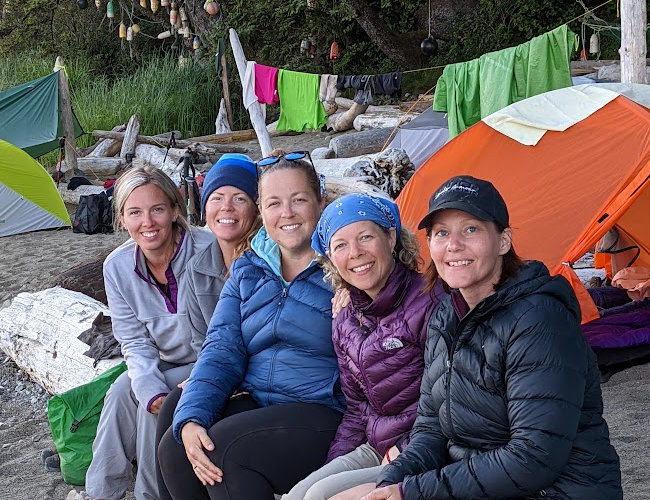
The ladies above (Erin, Candice, Amanda, Shannon, Ericka) followed the same itinerary as us. They did not all hike together through the day, but every afternoon or evening they eventually arrived at camp. Over the days, it was enjoyable to hear about their adventures, including getting lost, bushwhacking, and falling in mud. Pretty much every other obstacle you may hear about this trail seemed to happen to one or another of them at some point, but they persevered and fared as well as most.
One hiking pair that rode the shuttle bus with us was a father and young son. They were excited to hike, but after our boat ride with them across the Gordon River, we never saw them again. We got word on the second day that the dad had a boot blow out on the first day so they had to turn around and leave - hopefully, he fixed it and did a reboot (get it?).
Others from that original group would leap frog with us over the next days. One Canadian fellow had hiked the trail a couple times and shared a lot of information from his past experiences.

Upon reaching the northern terminus early in the day, we were greeted by a Trail Guardian, someone that maintains the trail, helps hikers, and shares local culture. My wife asked him if he'd take our group photo which he eagerly did, and surreptitiously got a couple of himself in as well. This is Kevin, whom I later learned is pretty well-known on the trail since he's been working on it for over 23 years now.
This year, Kevin has been sharing salmon with hikers that arrive at the terminus on Thursday afternoons - we missed it. He is also part of a crew responsible for the northern 25KM of the trail - there are 3 such crews, breaking the trail into three 25KM sections. It was a joy to chat with him for quite some time while he sharpened his chainsaw.
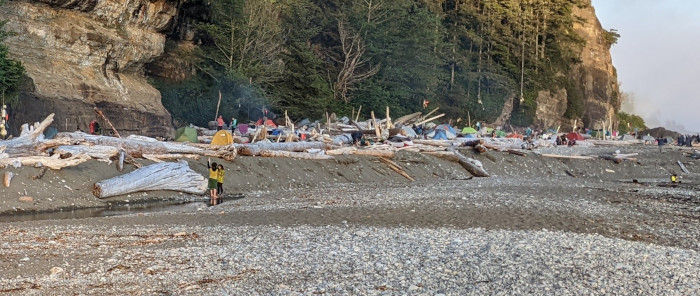
There were more women than men hiking the WCT during our time on trail. The last person we met on trail was at about kilometer 3, and she was a spitfire just heading south all by herself. All smiles, enthusiasm, and energy, with a small, light gear setup. I have no doubt she cruised down to the Gordon River without a care.
I noticed the diversity of hikers, too, and it was refreshing. On the long trails I've hiked, the typical hiker is a lean white male. The WCT is exceptionally different from that with a wide range of skin colors, body sizes, ages, and even languages. I heard English, French, Japanese, and Spanish (I think).
It seemed to me that the general 'vibe' on the WCT is more easy going than on longer trails. There was not a drive to cover many miles. Taking time to experience the widely ranging trail conditions and varying scenery was a nice luxury. Having a few hours to lounge around after hiking a few miles each day gave it more the feel of camping than hiking. I suppose the shorter trail length and commitment of just a week rather than a month or more had a lot to do with this.
I'll share what our camp life was like on the WCT in a couple days...
08/03/2022

OMG, what a hike!
I just got back from a family backpacking trip - myself, wife, two sons, and a girlfriend. Seven days of hiking and camping on the West Coast Trail of Vancouver Island, British Columbia, Canada was a wonderful week in the wilds. I finished my trip report, but wanted to share a few pictures now.
The trail has plenty of ladders...
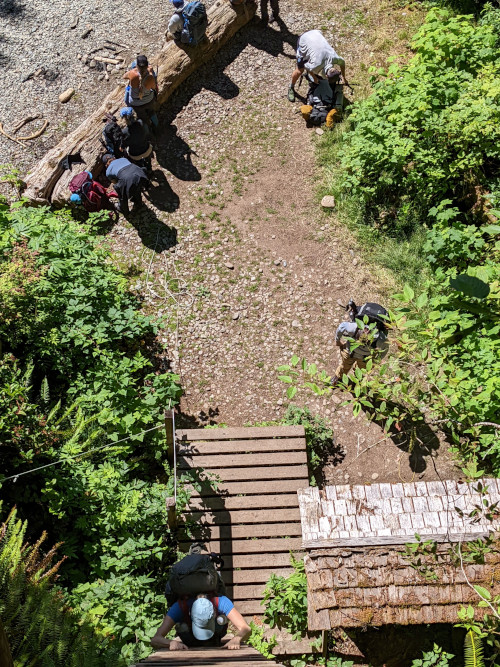
First (and steepest) Ladder right at the southern trailhead.

Ladders Going Up and Down
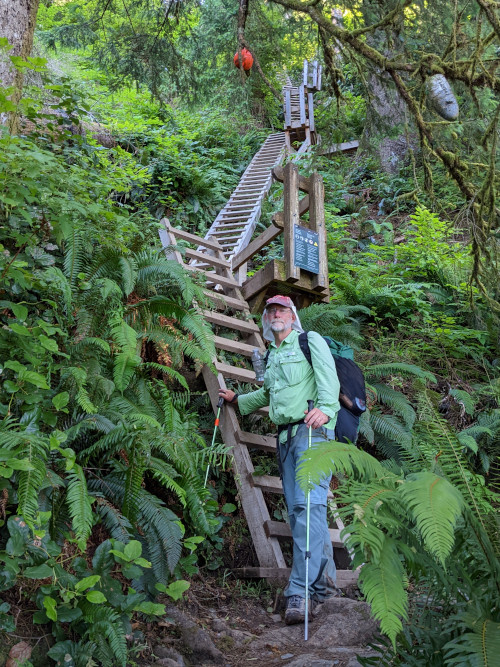
Ladders Upon Ladders

Nice Bridge Across River
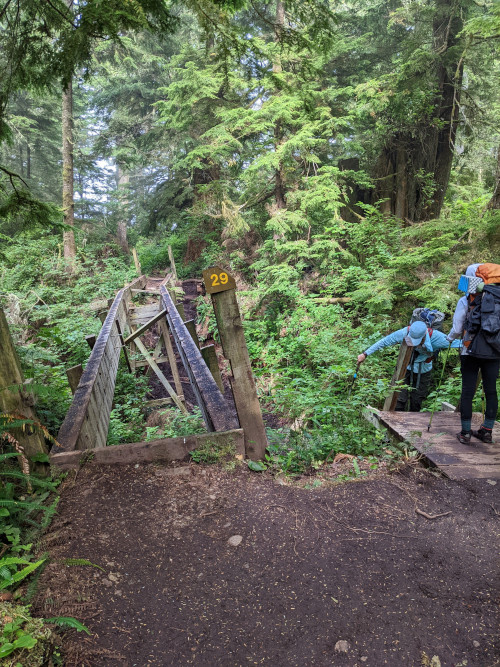
Not So Nice Bridge
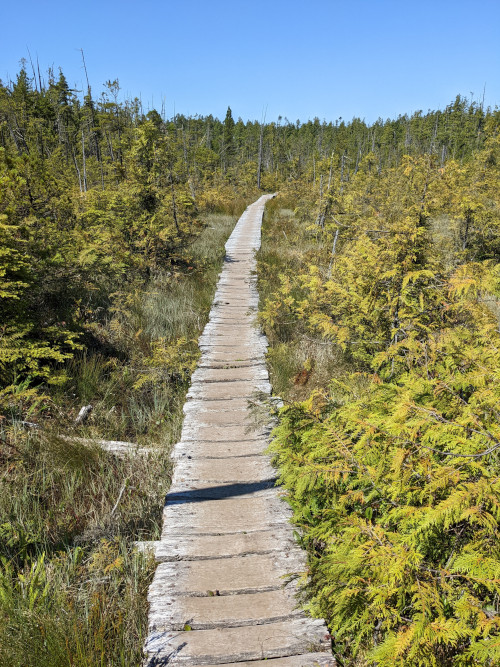
Nice Boardwalk
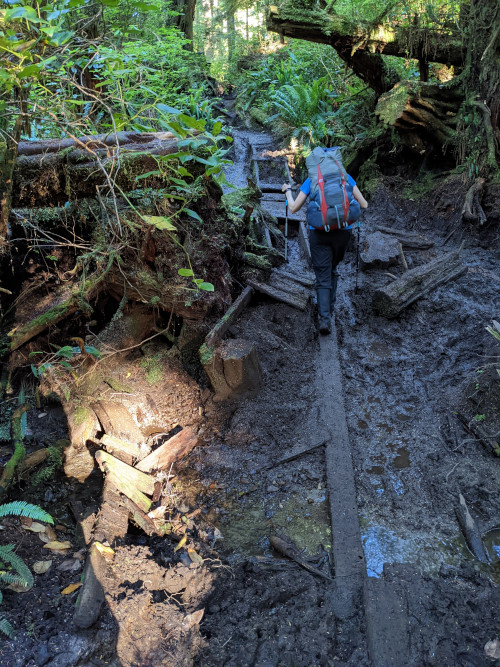
Not So Nice Boardwalk
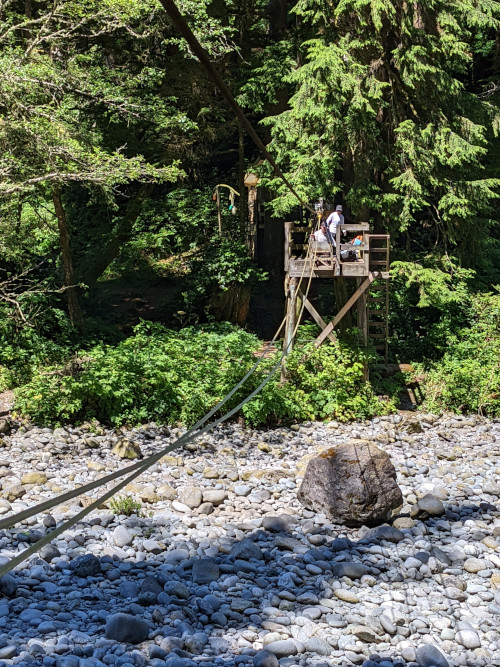
Cable Cars Are Fun

Easy Beach Walks
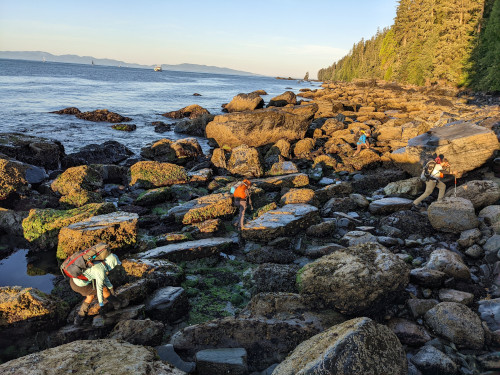
Not So Easy Rock Scrambles

The Trail was Flat...
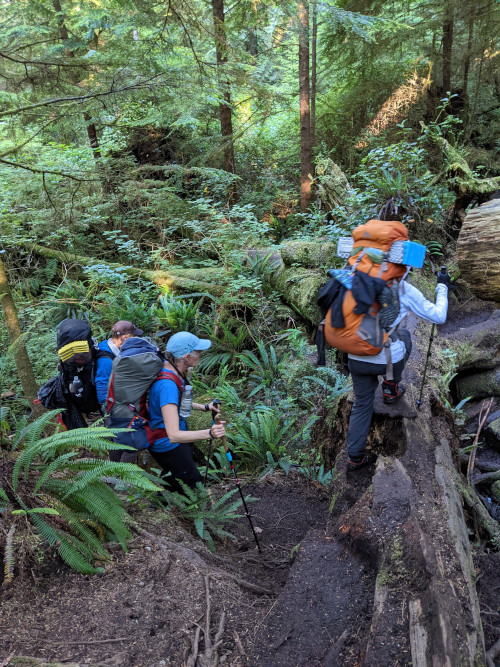
And Not So Flat
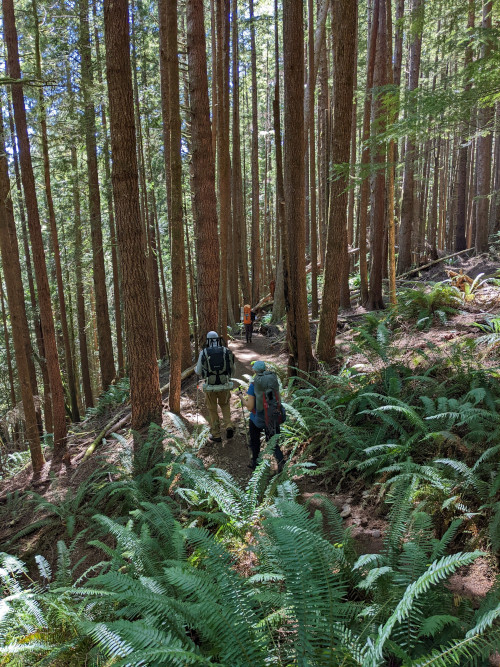
Beautiful Forest...
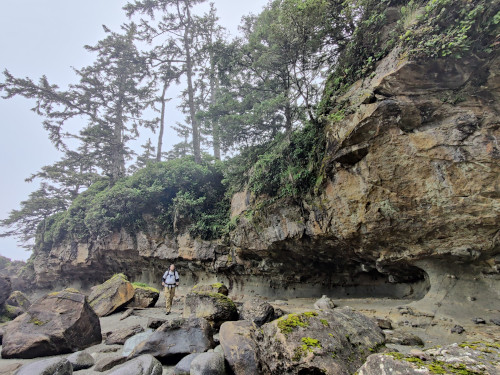
and Coastline
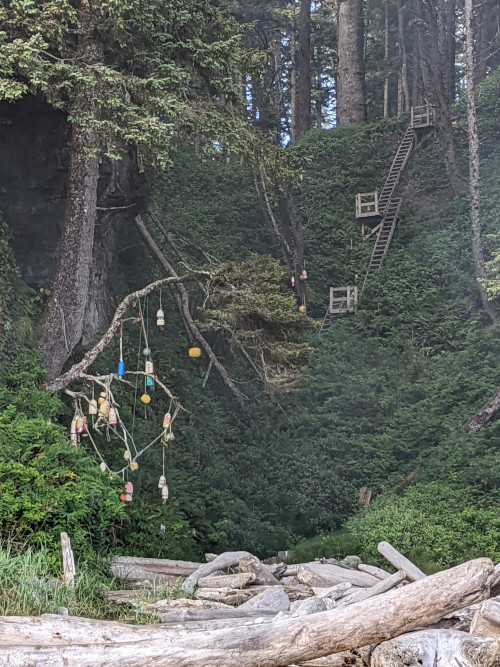
Buoys hanging in trees marked the trail into the higher forest...
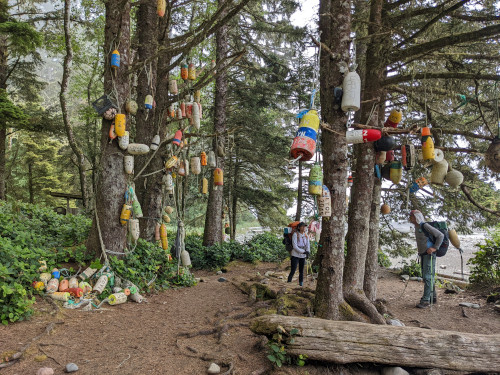
Or, they were just buoys in trees.

So, we added one found on the beach.

All the campsites were very nice.
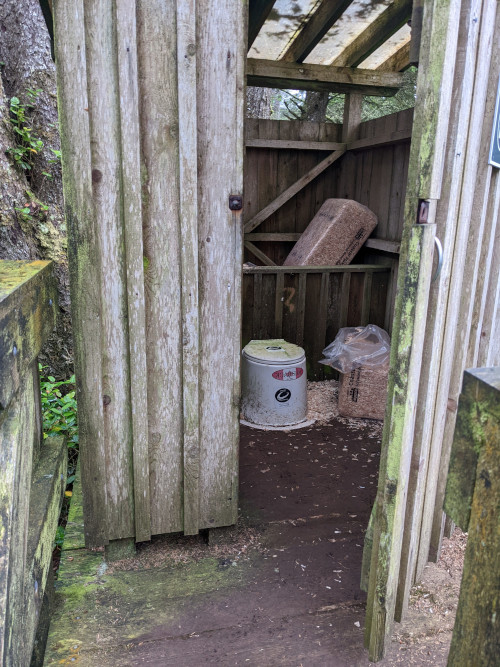
So were the toilets at each camp.

We made some friends.
And enjoyed so many things along the way...

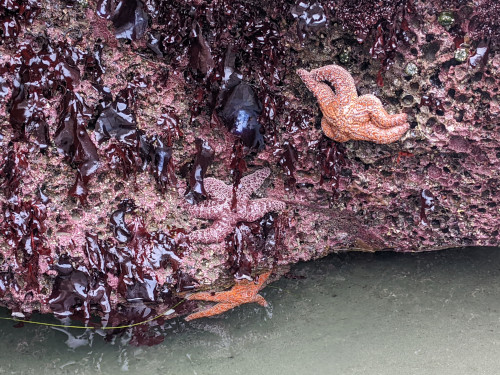
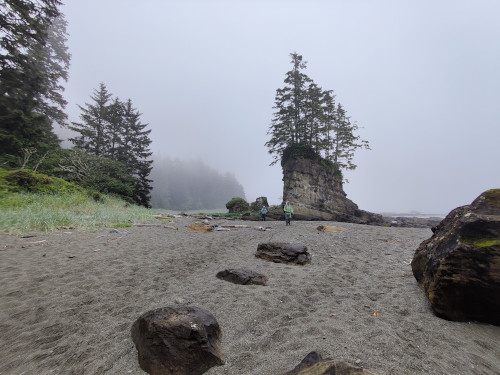
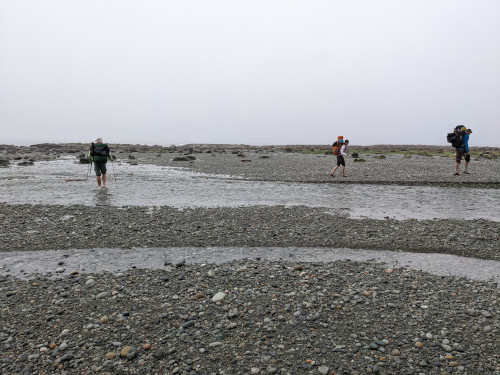
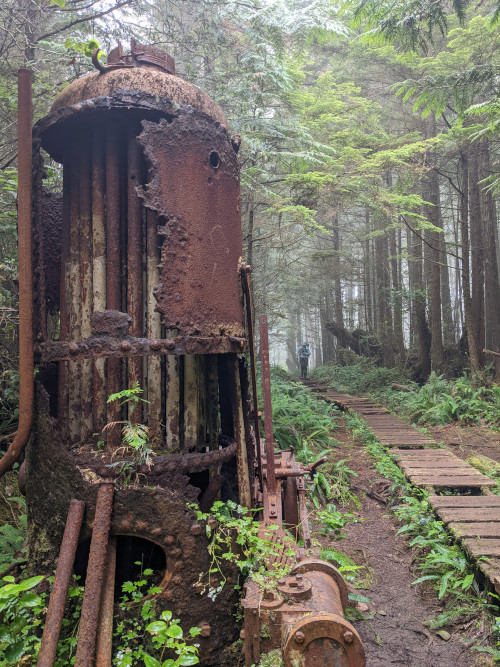

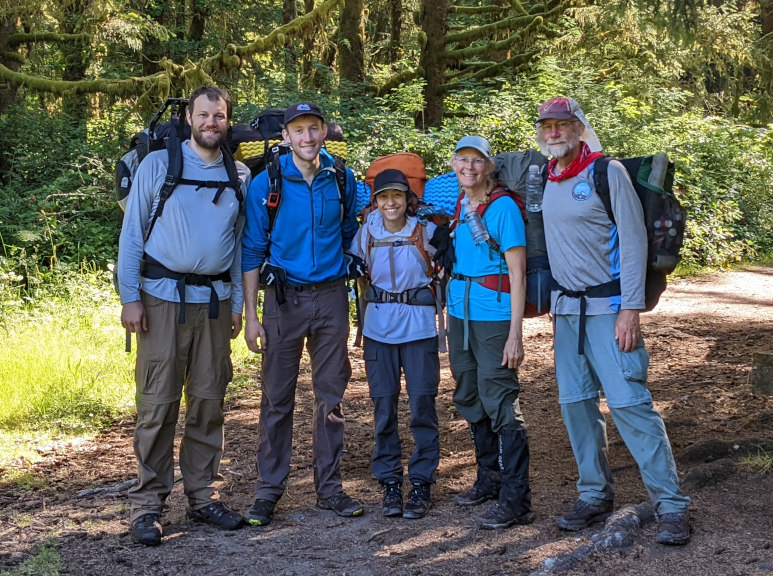
Until We Reached the End
Posted: 08/03/2022
10/04/2021

Besides hiking a lot, I brew beer. Homebrewed beer has a lot more character than mass-produced beer, and it's usually unique, flavorful, and powerful. I just discovered that craft jerky is definitely not the same as mass-produced 'jerky', and is more like homebrew - unique and packed with flavor!
TL;DNR - I taste tested this dirty dozen bags of Righteous Felon jerky to see if the product was as good as the hype. Oh, yes! It was a rainbow of flavors, ranging from sweet, sugary, barbeque to eye-sweating chile peppers, with some detours through a plethora of herbs and spices along the way. Just go buy or steal their Righteous Sampler for yourself and get all 12 flavors - use HIKING10 promo code to knock 10% off the price, or off your jail time.
What's This About? - The righteous folks sent me a box of craft jerky to try. They do all their dirty deeds in Pennsylvania, not far from the Eastern PA State Penitentiary if that tells you anything. The claim is that small-batch, craft jerky just murders the big brand, always the same, jerky stuff that you're used to gnawing on. I've eaten plenty of jerky on my long hikes and it's pretty much just a salty snack to chew away on while putting in miles. So, I did a 12-mile hike and 20-mile bike ride this weekend, and took my sack of jerky along. I wanted to see if craft jerky is any different - my oh my, this weekend set me straight!
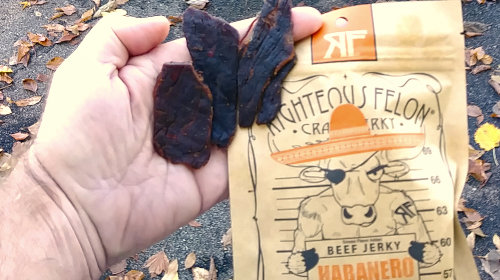
Where's the Beef? - You won't be wondering with this jerky. It's all prime cuts of American Black Angus beef raised outdoors in pastures in Texas and Maryland, and free of antibiotics and growth hormones. A cool thing about this jerky is it's just beef, lots of beef - and no unpronounceable preservatives and chemicals added. And, that means a solid protein source for hiking and other outdoor activities that challenge your body to recover from hours of muscle stress.
It's Just Jerky, Right? - Yeah, no, I thought so, too. The Righteous recipes all have that solid Beef as their main ingredient, but every recipe has its own mix that delivers a unique taste bonanza. I tried the whole dozen and have ranked them in order of my preference below. I noticed a few things about ALL the choices:
- Good Meat - some pieces were softer than others, but generally all of it had a good, healthy chew with nothing too hard or tough. Consistently good texture and a nice beefy flavor throughout.
- Flavor Over Salt - not overpowering or bland, just the right amount of saltiness letting the real flavors come through. The Maryland Monroe flavor was the only one that tasted a bit too salty for me.
- Unique Taste - the recipes made for very different tastes, each with their own style.
- Fun Names - each recipe is a play on some famous name, each having something to do with the flavor.
But, Didya Like It? - It turns out I kinda prefer hot & spicy jerky, followed by sweet & smoky, with strong herb seasoning bringing up the rear. But, there was only one that I didn't really care for: 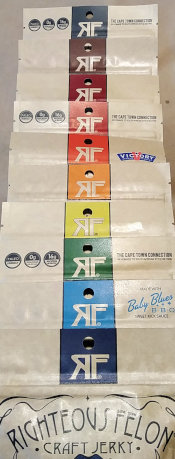
- Habanero Escobar - My absolute Fav! Habanero peppers take their time in releasing the heat as you chew this jerky. It started a bit sweet, but that was overtaken by the habanero heat after awhile. Lock this one in the vault!
- Ancho Villa - Ancho pepper heat builds as you enjoy the beefy biltong. These Mexican peppers may have been smuggled in, but I don't care.
- Voodoo Chile - What do you expect from the world's hottest chili pepper? Yeah, it's HOT!!! It started slightly sweet, but the heat exploded after chewing for awhile when it was too late do do anything about it. The back of my tongue got hot, then my throat, then everywhere. I sweated more chewing this than that time the popo interrogated me in the Big Apple.
- Bourbon Franklin - Pretty much the polar opposite of the Voodoo Chile recipe, this bourbon and vanilla bean jerky is just as much fun. I enjoyed this sweet smelling, sweet tasting jerky almost as much as conjugal visits during my time in San Quentin.
- O.G. Hickory - This is pretty much what you'd expect from a hickory smoked jerky. It tastes and feels great, but no wild taste sensation. If you're a boring white-collar criminal skimming pennies off the ledger, then this is your jerky.
- Baby Blues BBQ - From the name, I wanted it to taste like barbeque sauce but I didn't get that. A little habaneros & serranos peppers provide some heat to balance the BBQ sweetness, so it's a great choice for an illegal poker night in Minnesota when the guys want to get rowdy.
- Darth Garlic - OK, this one was pretty weird. There's no saltiness. There's no sweetness. There's no heat. Weird, huh? It smells and tastes really good, though. It's just like chewing on a moist, tender, seasoned slice of beef.
- Truffle-o Soldier - Mushroom jerky is a new one for me, but it's certainly an interesting taste treat. Opening the package, I could not identify the aroma. Chewing it, I could not identify the taste. But, a definite earthy, mushroomy aftertaste lingered around. The truffle flavor comes from contraband seized in a Pennsylvania raid and then lifted from the evidence locker by Light-finger Lefty hired by the guys at Righteous Felon - but don't tell anyone.
- Maryland Monroe - Impregnated with hickory & crab spice, this jerky tastes a whole lot like the Old Bay seasoning in the pantry at Norma Jeane's house that she uses on shrimp, salmon, crab, whatever. The celery salt is pretty powerful, making this the most salty tasting of the bunch.
- Victorious B.I.G. - This is the one flavor I was really looking forward to trying. The hype said it has some beer flavoring it, so of course my imagination took over and I was expecting a chewy chocolate stout. Alas, all I got was a great tasting, sweet jerky with a potent black pepper punch. If I was honest, instead of a scoundrel, I'd rate this higher, but I'm still bummed about missing the beer taste.
- Fowl Capone - Best Name award winner! If you like the aroma and taste of basil, corner the market on this jerky. It smells like my wife's basil plant, definitely basil tasting, somewhat sweet with lots of herbs.
- Nelson Mandilla - Obviously, this biltong was secretly transported through Righteous Felon's South African connection. It was hidden inside a cargo of fresh dill weed inside a slowboat across the Atlantic for 3 weeks. It has a powerful dill aroma, and tastes like chewing on a dill plant, not salty, not sweet, not peppery. My taste buds just didn't get along with this one.
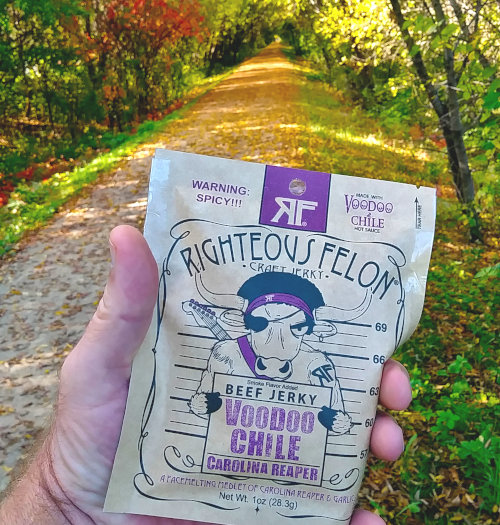
The HOT One!
Is This Legit? - You can't really trust a gang called Righteous Felon, can you? So, listen to me instead. After all, I've never been convicted of any felony:
- It's Gluten Free, except for Bourbon Franklin and Victorious B.I.G. due to the booze used in their flavoring.
- Made in USA, baby!
- High protein, and that's the whole reason for jerky anyway, 'miright?
- Simple ingredients! Here's what's in my favorite Habanero Escobar - beef, water, brown sugar, soybeans, salt, molasses, chipotle pepper, vinegar, black pepper, natural smoke flavor, alcohol, habanero peppers, garlic powder, onion powder, red pepper, paprika, cloves, chili powder.
What's the Catch? - Go to https://bit.ly/2Z5n20y and use HIKING10 for 10% off your order.
Check out Righteous Felon Jerky Cartel to wina buncha jerky fer yerself before Oct. 8 - yeah, that's this year, 2021, duh!
Pssst, Buddy, Down On Your Luck? - Righteous Felon jerky is around $44/lb which is right in the ballpark of other high-end jerkies, certainly not cheap. The mass-produced, monotonous, chemical-laden brands are half that.
If you're looking to save a bit, they have 8 ounce bulk bags of jerky that saves about 14%.
If you're feeling adventurous, they've also got Shredded Jerky Chew which is a hodgepodge of all their jerky bits thrown into a bag. You don't know what flavors you'll get, but it's just $16/lb! Perfect for a hungry hiker wanting a surprise selection of snacks. It's all good.
Finally, the cheapest option is a bag of their meatstick nubs, the ends from their meatsticks. Same good meat and taste, just bite-size pieces for $12/lb.
Biltong? Huh? - Yeah, new to me, too. Biltong is just a different way to preserve meat. It's like jerky, but air dried for many days without heat rather than with heat. It originated in southern Africa while jerky comes from South America. Now you know. Your day wasn't wasted!
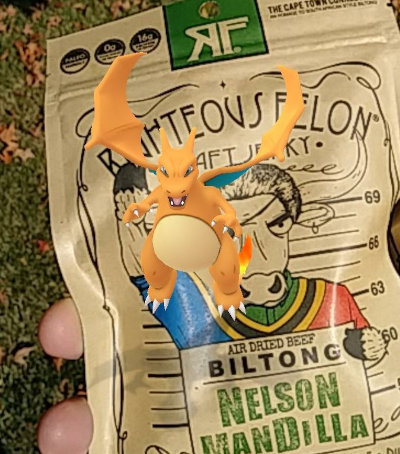
Great Pokemon GO snack - Catch 'Em All!
Posted: 10/04/2021
09/29/2021

Have you ever planned an epic adventure and then at the last minute have something happen so it had to be cancelled? I'd love to hear about it in a comment...
This week was supposed to be an Up North Minnesota adventure on the Border Route Trail with my wife. Last year, she set an FKT on the Kekekabic Trail, so we wanted to continue along the longest of trails at 4600 miles - the North Country National Scenic Trail this fall.

Unfortunately, a summer knee injury has just taken an extra long time to heal, and I couldn't work out logistics for a solo trek, so we have to delay this adventure to next year. We can't even blame covid for this one.
I believe it's better to plan for more and settle for less. That way, you're seldom caught with nothing to do even though you will occasionally not have a plan come together - and that's just fine. I've racked up about 1000 miles of hiking in the mornings this year, so it's all good! I'm still trying to wear out my Kuhl pants and they're going strong.
Just this past week, my son told me to download Pokemon Go to my phone. I thought that was all over and done with, but I guess there are more people playing it now than when it came out 6 years ago. Anyway, I've been playing it for a week and have discovered that I walk slower but the time passes much faster. I'm up to level 25 and still haven't figured out how to raid a gym with other players. :-) Well, whatever gets you out on the trail, right?
Hike On!08/30/2021

Following my blog for awhile will have made you aware that I have evolved to no-cook food on my long hikes. This eliminates the weight of stove, fuel, and cooking utensils. It's a fine way to go unless you absolutely must have your coffee in the morning or a hot meal at the end of the day. When I'm on a trek with my wife, I slow down and we take a stove since she still looks forward to hot food.
When the fine folks at RightOnTrek.com asked me to give their backpacking meals a try, my Wyoming adventure this summer turned out to be a good opportunity to do so since we weren't doing big miles and someone else was planning to bring a stove anyway. All I had to do was carry an extra fuel canister.
RightOnTrek has a dozen dinner meals and a half dozen breakfasts to choose from. I tried six of their meals and every one of them was a hit for ease, taste, and calories.
If you'd like to easily get all the food for your trek, the RightOnTrek has developed a Menu Planner where you can create a meal plan for up to two weeks that includes all meals as well as snacks. Their tool puts together food that provides the amount of calories you define and then charges you 1 cent per calorie. An example 5-day trek with 3000 calories per day took me less than 1 minute to create and had a price tag of $150. This is a great tool for someone wanting to spend less time planning food and more time hiking.
Alternatively, you can just purchase the specific meals you want and gather your own snacks and extras - this is what I did.
All the meals I tried tasted great, filled me up, and were easy to make. Here's my meal-by-meal scorecard: (click a pic for large view)
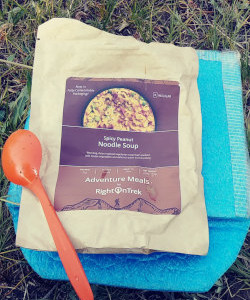 Meal 1 - Spicy Peanut Noodle Soup
Meal 1 - Spicy Peanut Noodle Soup
Score: 9
Pro: The soup was excellent, hot, and filling.
Con: 3 little packets to open and add to the noodles - peanut butter, hot sauce, & soy sauce. It tasted great, but all the packets were a pain and created lots of small pieces of garbage and messy drips.
Other: Since it's soup, you can add as much water as you want. Especially if it's a cold, dreary day, I add extra water so I'm enjoying the warmth longer and helping with hydration.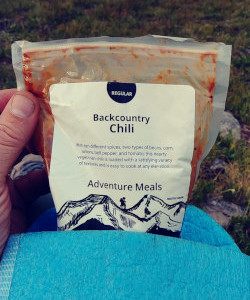 Meal 2 - Backcountry Chili
Meal 2 - Backcountry Chili
Score: 10!
Pro: Simplest meal, and definitely my favorite. Very tasty and really spicy. I found that 6oz was a good meal size. It's vegetarian but still has plenty of protein from beans and lots of flavor from corn, rice, bell pepper, onion, and tomato powder.
Con: Might be too spicy for some.
Other: Really, this was good! Even the sump water tasted good.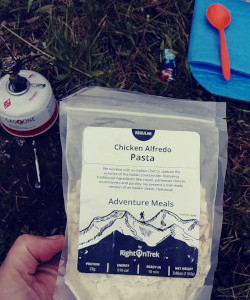 Meal 3 - Chicken Alfredo Pasta
Meal 3 - Chicken Alfredo Pasta
Score: 7
Pro: Chicken chunks rehydrate better than any other meat and it gives this a real meal feel. The mushrooms also felt and tasted like mushrooms.
Con: This one was kind of bland, but tasted fine. It's alfredo, so it's not supposed to have much zing.
Other: It's amazing how powdered milk, cream, and parmesan cheese can turn from lightweight powder back into smooth, tasty food.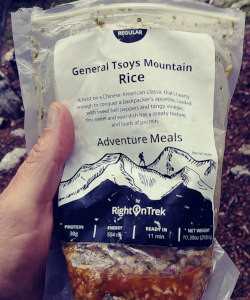 Meal 4 - General Tsoy Mountain Rice
Meal 4 - General Tsoy Mountain Rice
Score: 9
Pro: Great tasting and fast rice meal. I've had poor luck with rice before, but this rehydrated perfectly.
Con: This meal had four tiny packets to add, and many steps in the instructions. Fortunately, you can skip all the instructions (see below).
Other: I think I could live off this and the chili for a month in the wilderness and not complain about meals.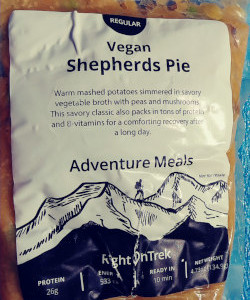 Meal 5 - Vegan Shepherd's Pie
Meal 5 - Vegan Shepherd's Pie
Score: 9
Pro: Mashed potatoes really fill you up. It tasted pretty much like what I make in my dutch oven, only super fast to prepare.
Con: Too much pepper taste for me.
Other: I think there was a mistake in the packaging of ingredients. The instructions did not match the included packets. There was a packet of hot sauce included that was not mentioned, and only 1 oil packet when 2 were mentioned in the instructions. I just cooked it all! My friend from Australia was on this trek with me and he got pretty upset when I said it was Vegan shepherd's pie - he said that's just not right. :-)
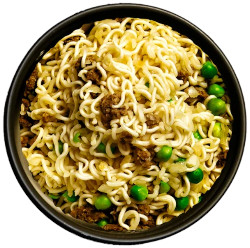 Meal 6 - Beef Ramen Soup
Meal 6 - Beef Ramen Soup
Score: 8
Pro: Like all the rest, the ramen tasted great. The 'meat' rehydrated fine and had a good feel of substance.
Con: It was ramen noodles, so they're always pretty good - but it was just ramen, and little packets of sauces.
Other: It was raining too much for a photo of this meal, so this is what it's supposed to look like. :-) The description says it contains ground beef, but it sure seemed like TVP (textured vegetable protein). Either way, it was good. Well, I found the packet of oil that was missing from the Shepherd's Pie meal - probably someone dropped it in the wrong bag when packaging.
- They have from 21g to 29g of protein and 515 to 577 calories per each regular size meal.
- Most meals had a few little sauce packs that had to be opened and added. Things like soy sauce, peanut butter, oil, hot sauce, ... Besides the oil, I think most of those could be dried spices packed right in the meal to save the futziness, trash, and mess.
- Every meal tasted great and there was plenty of food every time.
- Calories and weight are similar to other well-known brands. Price seems to beat others by about 15% or so. If you have 4 people, buy their 'Serves 4' package size and one person eats for free, or about a 25% additional savings - so that puts their price in a very competitive spot. The larger size also saves on weight and trash.
- A big reason for using these bagged meals is to make 'cooking' easy - just add hot water and wait. These meals have multi-step instructions that have you put the contents in a pot, boil awhile, add packet ingredients, and then wait. I'm sure the detailed instructions work great, but Forget That! I just dumped the packets into the bag, poured in hot water, set it in my cozy for 15 minutes, then ate it. Absolutely every meal rehydrated wonderfully and tasted very good.
You can see my blue cozy in some of the photos. A cozy makes life much easier and meals hotter. The insulation keeps the water hotter longer and lets you set the bag anyplace to rehydrate. It can also be used as a small cushion/dry/clean spot to sit. I have Cozy Instructions for my old cozy, but the one I use now is just blue foam folded over and taped - works just as well. - Besides the ease of cooking, rehydrating in the bag also makes clean up fast and simple. No pots to clean! Just pour a little more hot water in the bag, seal it, and shake it. Then drink the water and roll up the bag into clean trash. Presto! That's called Sumping and wastes no food and leaves no crumbs in the woods.
- One concern about rehydrating directly in the bag that the food came in is the possibility of punctures and then leakage. When I made my Shepherd's Pie, it had a tiny pinhole after being tossed around in my pack for 5 days. It did not leak when rehydrating, but did a bit when I sumped the bag. So, just squeeze the bag before opening to check for air leaking out.
- If you like spicier food, it's always a good idea to carry a small 'spice kit' with what you like most so you can jazz up whatever meal you make.
- Oh, and really invest in a long-handled spoon. These bags, like others, are deep and get your hand messy. I'd love to see a shorter, wider bag - like with the zipper opening on the side instead of top. Spoons range from free red plastic in a DQ blizzard, to $5 bamboo, to $30 titanium. They're all about 8 inches long and do the job.
As our society evolves, people are tending to acquire less stuff and we're moving more toward a Sharing System where a person can select a belt sander or pruning shears or whatever off a website, have it delivered, use it, then have it picked up when finished. That one belt sander can be used by 30 people in a month instead of 30 hammers sitting idle in garages for 29 days.
Besides the meal planner on RightOnTrek.com they are also rolling out a gear rental system which puts them right into this new model of business. You can plan your trek, select what gear you need, when and where you need it, and it will be waiting for you at an outfitter near your hike location - along with all the food for your hike. When you're done, you just return the gear and head home with no clean up and storage to worry about. I believe this sort of system will become the norm soon, so it's exciting to see a company embrace and advance it.
It's not too early to think about Christmas gifts for the hiker you know - a selection of meals would stuff a stocking nicely!
(RightOnTrek provided me with these meals to sample in exchange for this post.)
Posted: 08/30/2021
08/27/2021
Today's blog post is from my wife. Last week, she had a canoeing adventure in the Minnesota Boundary Waters Wilderness with friends. And, it included some hiking, so here you go...
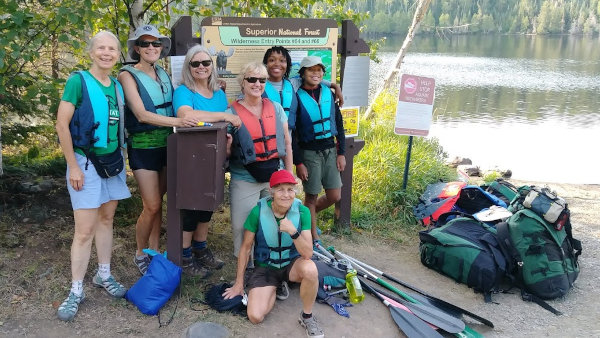
Our group of seven women (ages 15 - 68 with the majority of us over 55 years) spent 4 days in the BWCAW from August 20th through August 23rd, 2021.
Rockwood Lodge & Outfitters provided all of our gear and equipment in an extremely flexible and friendly manner. We decided to pack our own food (more about that, later), and since we were a church group, they offered us very reasonable, non-profit pricing.
We left the Twin Cities at 10:00 a.m. and arrived at Rockwood around 4 p.m. While Mike put together our equipment, we headed over to the nearby Trail Center Lodge for dinner. As always, the food was delicious and the staff cheerful and efficient.
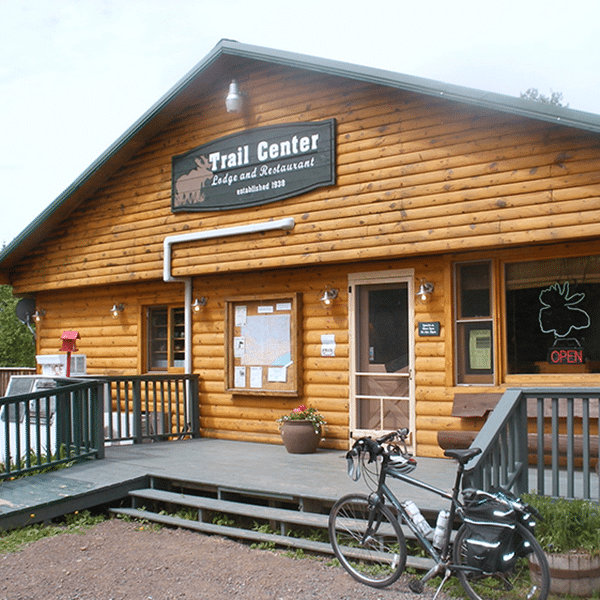
Then we headed back to Rockwood to do a gear/equipment check and begin packing our personal gear and food. Rockwood provided waterproof packs for each person which easily allowed two people to share a Granite Gear portage pack. We spent the night in one of Rockwood's bunkhouses (complete with a bathroom/shower & towels), and chatted with our neighbors who had just completed their trip and were happy to share helpful tips.
We were up and eating breakfast at 7 a.m. with the goal of an 8 a.m. departure time. Mike brought us hot coffee to enjoy with the muffins & grapes that we had brought from home.
After we watched the required video, Carl hauled our three canoes to the East Bearskin Lake entry point (#64), and we were on the water by 9:00 a.m. We paddled east along the south shore of East Bearskin Lake to the portage into Alder Lake. There, we met another group heading home who shared information with us about open campsites on Alder Lake and Canoe Lake. We continued paddling east on the northern finger of Alder Lake to the tip of the west shore peninsula where we checked out an open campsite (#705). It was smaller than we needed, and our plan was to leave the 3-person canoe at the site, and paddle on to Canoe Lake with the other two canoes to see if some of the bigger campsites were available. As we watched nine canoes head past us towards Canoe Lake, we decided that we'd all stay put, make this smaller site work for us, and enjoy a shorter paddle home on Monday.
We scouted the site thoroughly to find usable tent pads for our two 4-person tents and one small 1-person tent. The site had one good tent pad up the path from the fire grate area, and quite a few options for the 1-person tent, but finding a spot for the last tent was a challenge! Since fires weren't allowed in the BWCA due to extremely high fire danger, we were able to set up one of the 4-person tents near the fire-grate area.
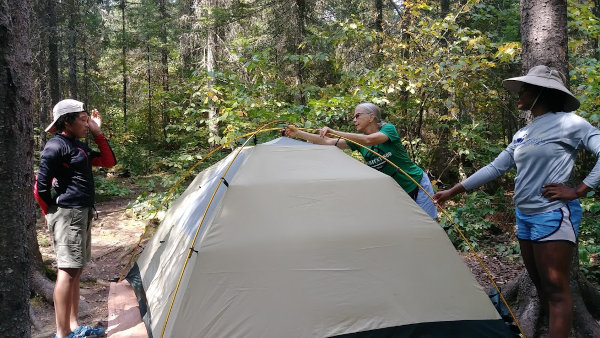
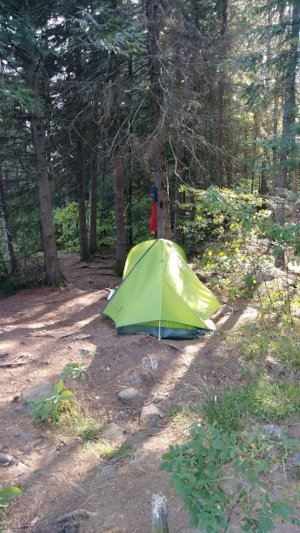
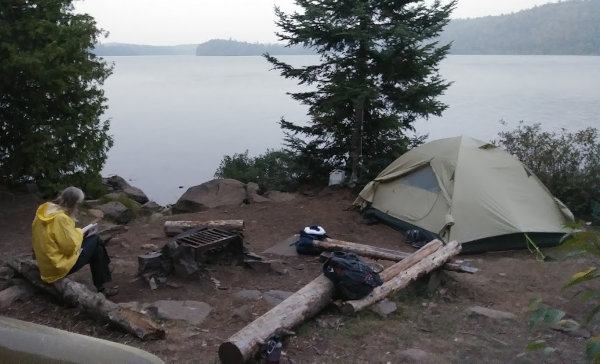
Next, we put up a tarp because we knew the forecast called for rain. This would give us a place to cook & eat meals if it was raining, and allow us to keep our portage packs dry (less weight to carry). We also set up the Platypus gravity water filter provided by Rockwood.
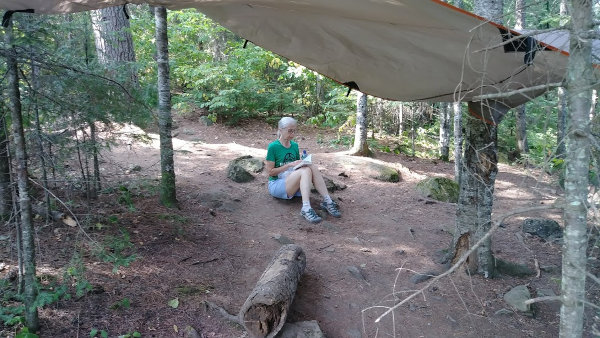
And then came our favorite group building, problem solving activity - hanging the bear bag! Our goal this year was to master the pulley system. We did pretty well, but based on the stories we heard from other campers on Lake Alder and Canoe Lake, it's likely that a bear could have taken our food.
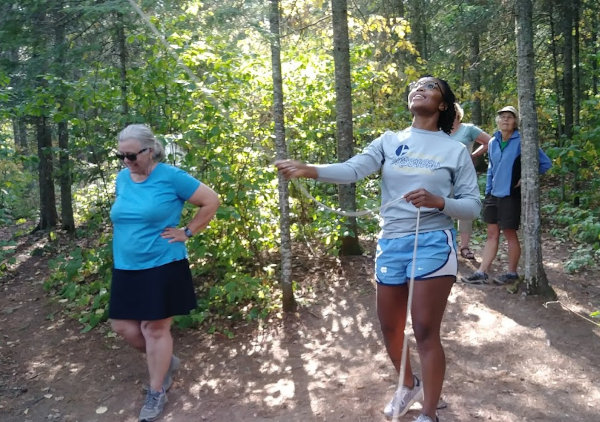
Sierra was our 'rock' star, using her softball skills to get our rope up and over a high branch. Then we used a method where most of the group pulled the food bag rope and a few people pushed up on the bag with paddles to get the bag up as high as we could. We kept all of the food, garbage and our toiletries in the bag except when we were eating.
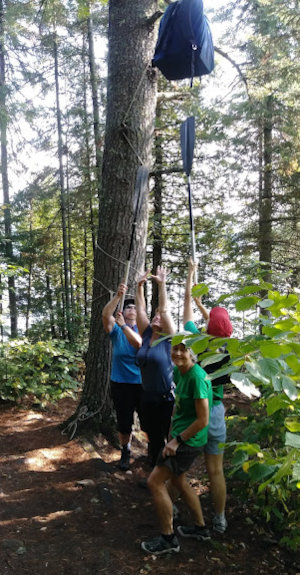
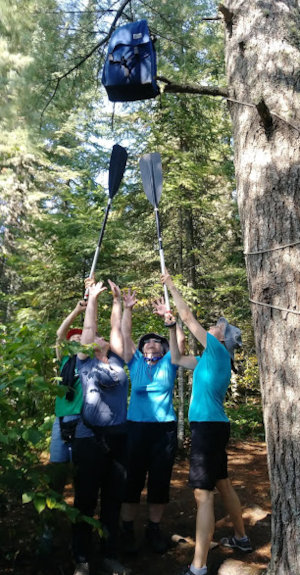
Speaking of bears . . . We met three different groups who had been significantly impacted by a bear stealing their food. This was something we had not encountered before, and certainly gave us pause. One group told of the bear coming into their camp while they were eating breakfast and going to their closed (but not locked because they were eating) bear barrel and taking the barrel of food into the woods. Another group said that the bear climbed the tree and jumped out to pull the food down. The last group reported that the bear clawed the rope tied to the tree trunk, so that the food came down. We were lucky that the bear didn't come to our campsite, because if it had, we would have likely lost most of our food and had to head home early.
We decided to pack our own food to save money, have the food we like to eat and have the right amount of food. We only needed one stove, a couple of pots with spoons for stirring, bowls, cups & spoons. For breakfast we had options such as protein bars, granola bars, and instant oatmeal packets. We also had hot cocoa mix & instant coffee. For lunch we had bagels, cream cheese, flat bread, sausage, cheese, peanut butter & honey. For snacks we had LOTS of dried fruit (apples, bananas, pineapple, mango & cantaloupe all dried at home the week before the trip), beef sticks, trail mix, candy bars & small bottles of water flavoring. Our dinners included Knorr alfredo noodles with Sweet Sue's chicken breast, Chef's Cupboard 3-bean chili (from Aldi) combined with a 4.5 tube of concentrated tomato paste and Knorr chicken rice with Sweet Sue's chicken breast. For dessert we had Knoppers - a yummy treat reminiscent of S'mores and found at Aldi.
Rockwood lent us nylon zip storage bags so that we could keep our food organized by meal. Each morning we put out the bags for breakfast food, snacks & lunch. Then we each used those options to eat a breakfast of our choice and pack our individual snacks & lunch food for the day using personal ziplock bags that we reused throughout the week
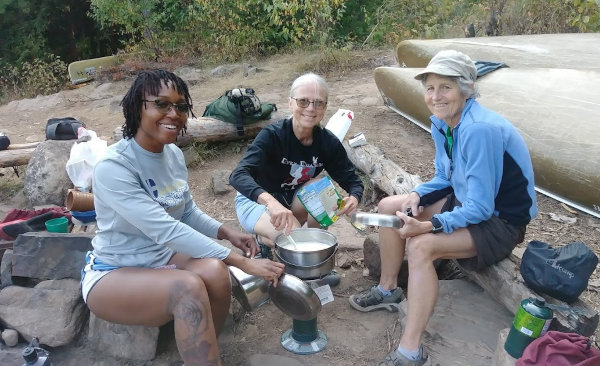

Saturday was a cloudy, windy day, but we headed out on a day trip with our rain gear, lunch/snack bags, TP, first aid kit, water, Katadyn water filter pump, sunscreen & bug spray. Our plan was to paddle & portage to Moon Lake and perhaps hike a bit on the trail. It turned out that the portage from the north finger of Alder into the north finger of East Bearskin was an unmaintained portage. We had to carry the canoes over several downed trees as we made our way along the steep trail. It was NOT fun. Once we were in East Bearskin, the wind picked up and we were paddling in white-caps. We stopped as a group to make decisions about continuing to Moon Lake, returning via the longer water route, or returning via the unmaintained portage with less time on the water. We decided that paddling in the wind and white-caps wasn't a safe choice, and although we REALLY didn't want to repeat the unmaintained portage, that's what we did. Our return to the campsite was challenging, but we made it safely and enjoyed some much needed rest for the remainder of the afternoon and hot chili for dinner.
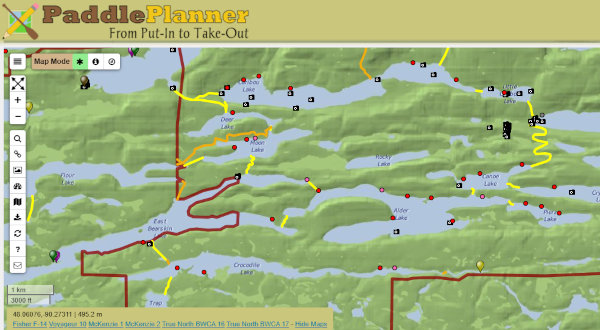
Sunday was, as we expected, sunny with very mild winds. We filled our day packs for our adventure to Johnson Falls, including swimsuits and towels. When we arrived at the Zig Zag portage at the far east end of Canoe Lake, we stowed our canoes, paddles & life jackets in the woods, and hiked for 45 minutes to Lower and Upper Johnson Falls. We enjoyed a beautiful lunch break at Lower Falls, and Kelly & Deb braved the cold water for a refreshing swim! Also on Sunday, our youngest & oldest group members learned how to portage the canoes.
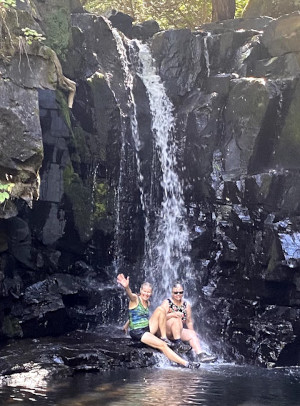
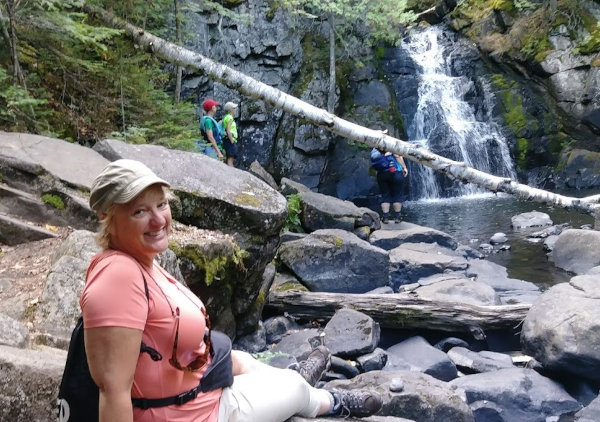
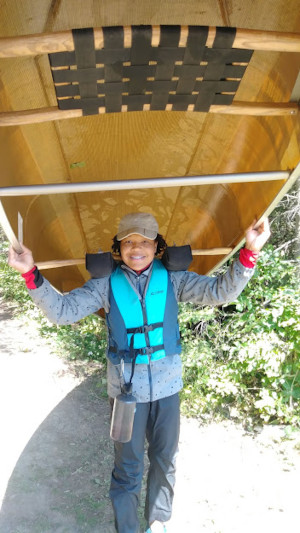
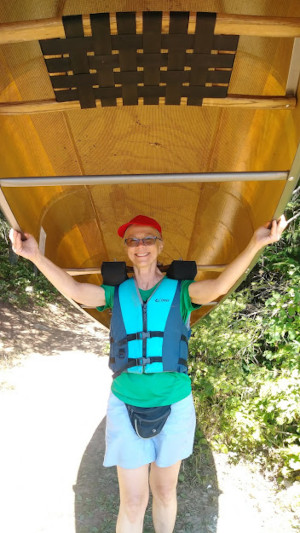
Monday morning we packed up, made sure our campsite was clean, and were on the water by 8:00 a.m. As we headed west on Alder Lake, a canoe with two Forest Service employees stopped us. We were sure that they were going to tell us about the bear problem, but it turned out that they were letting us know that the entire BWCAW was closed due to fire danger (for the first time in 40 years) and that we needed to leave. They had started informing groups to leave on Saturday, and lucky for us, they didn't get to us until Monday.
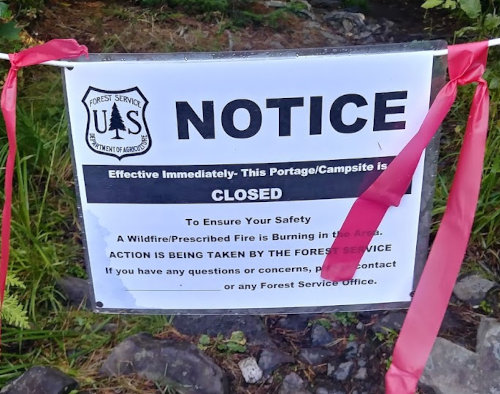
We were able to enjoy our entire stay in the BWCA despite bears and forest fires. Here's a link to our trip on Spotwalla.
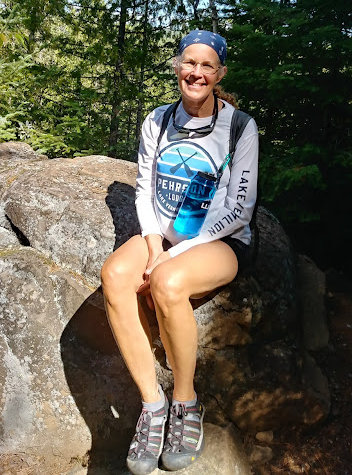
Guest blog by Kelly Kautz
08/12/2021
Last you heard from me, I was done with our short Cloud Peak warm-up 2-night hike and just getting ready for my first horse ride in 12 years. I survived and made it home, so I can finally share the highlights!
Here's the 3-part map of this little adventure. Cloud Peak in the upper-right, then a 5-hour drive to Pinedale on the left, and Cirque of the Towers at the bottom.

The steep and rocky hike into Cloud Peak was short but strenuous. My brother made it, and even managed a couple smiles along the way. We had nice weather while here, but the wildfire smoke was in the air from horizon to horizon.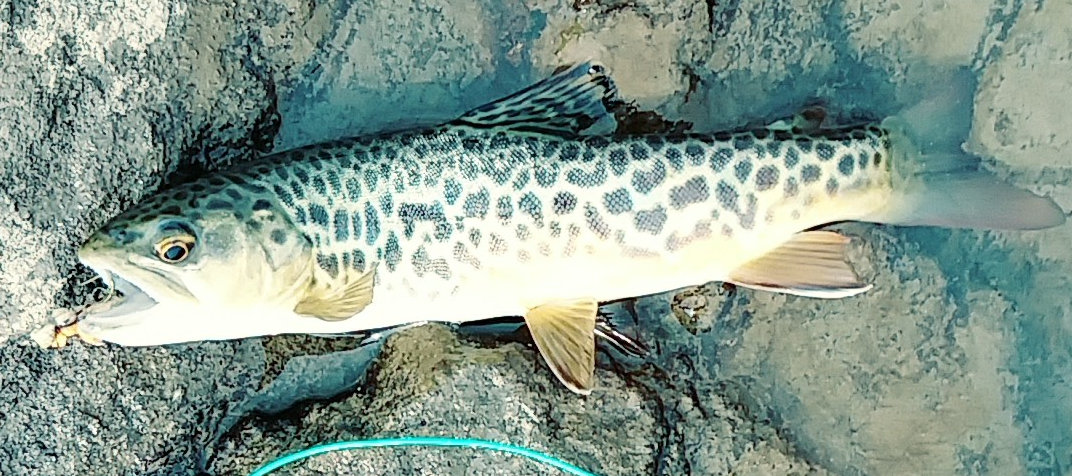
I did some research and found out that I did catch a few Tiger Trout in Long Lake. This beautiful fish is a sterile hybrid created by crossing a female brown trout with a male brook trout. They are created at WY's Story Hatchery and then stocked in a few dozen WY waters as well as other states.
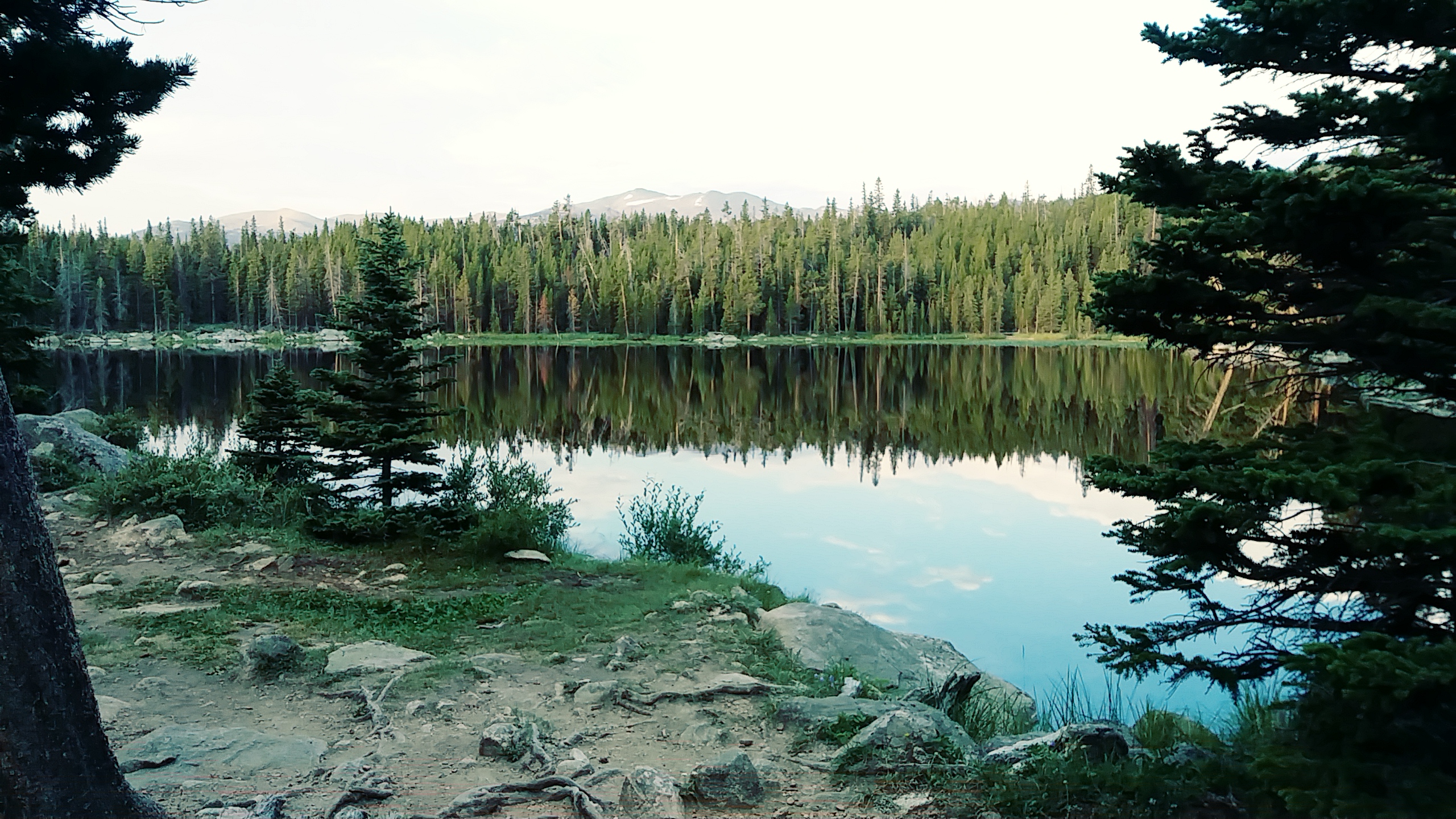
We camped two nights off the trail in the woods near Sherd Lake. Sherd was not productive at all, but our day hike to Long Lake and Ringbone Lake produced dozens of fish, mostly out of Long Lake. Also, Oliver Creek was full of brook trout that weren't picky about what they ate.
A 5-hour drive got us to Pinedale on the west side of the Wind River range. We were a day early, so we got a hotel room and had a whole day to relax. A dozen guys from across the country would all arrive over the next day. We packed our gear into duffels and delivered them to the outfitter for mules to carry in for us the next morning.

I got to spend my 5-hour trail ride on Rosie. She did a great job and didn't get up to much mischief, except she liked to brush up against trees a lot. Probably hoping to knock me off her back.
The ride was a fun experience, but got a bit tedious after a few hours. It is sure a lot faster and easier than hiking, especially going uphill. The horses just keep moving along at a steady pace all day.

When we arrived at our camp location, the outfitters unpacked all our gear, hopped back on their horses, and we were on our own in the wilderness for the next four days. The left us at a spot they called 'Dead Fred' because their story was that one of their horses named Fred had died there a few years ago. He was trying to keep up with some mules and had an accident, breaking his neck or something. Anyway, it was a beautiful spot just off of Pole Creek and within 2 miles of six fishable lakes.
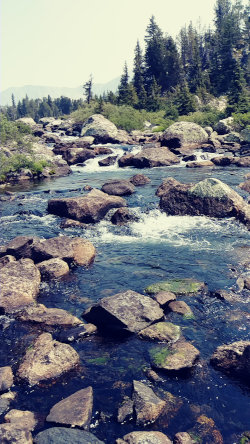
The first day, we fished Pole Creek and caught many brookies along the mile or so section. It's a wonderful creek with many small rapids and pools with aggressive fish. I used a foam black ant dry fly that worked all day.

The second day, we hiked a bit over a mile to a nonamed lake right on the Continental Divide Trail. I caught two lake trout on spinners right away and then caught many brook trout on flies and spinners the rest of the day. The lake trout were deep and did not fight, but the brook trout put up a good fight. We fished the entire perimeter of the lake and climbed over a ridge to fish two other lakes which yielded a few fish each. On the way out, we tried a small but deep overflow lake. It was full of fish.
I hooked what felt like a small fighting brook trout, but then it suddenly stopped fighting and was just heavy like a log. I gradually reeled it in until I could barely make out the form of a very large fish body. Then, that fish swam away and I easily reeled the small trout in. I believe it was a lake trout that bit the small brookie in distress that was on my hook - but I guess I'll never know for sure.
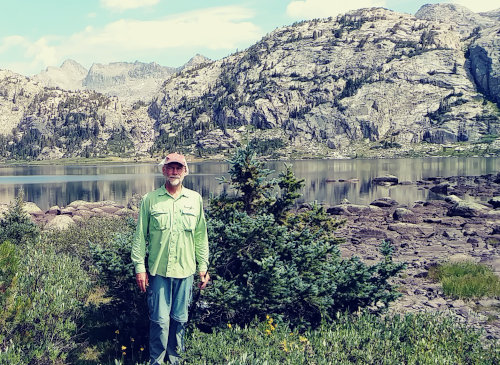
The third day, we hiked up to the two main Cook Lakes. These were big and deep with no surface activity, so I stuck to spinners. We made a large loop hike, catching a fish or two at every spot we tried. One large brookie took a hook too deep, so we carried it back to camp and shared it with the others at dinner. All the other fish were successfully released on this trip.

On our last day, the outfitter was scheduled to arrive between noon and 2pm. I had originally planned to hike south on the CDT to meet my next adventure buddies, but the forecast is for rain the next three days. So, I changed my route and hiked out to the trailhead and get a ride with my brother around the range to Lander. I packed up and started hiking around 9:30am, not knowing how bad the trail would be.
Along the trail, I like to think I'm pretty good at keeping my eyes and ears open. I noticed this moose off to the side as I walked by and we just watched each other for about a minute and then went about our business. Other than him, the only other wildlife was chipmunks, squirrels, and a couple deer.
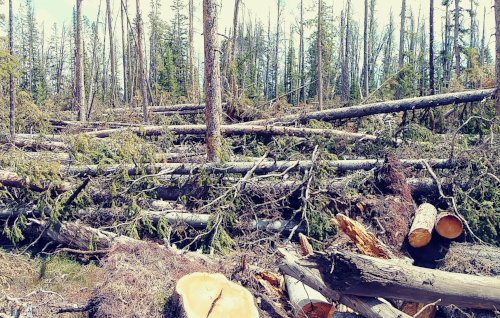
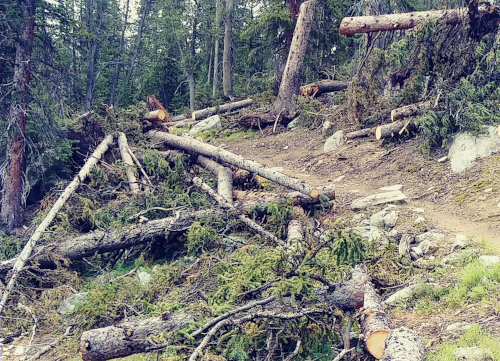
The most remote 2 miles of trail were still impacted by blowdowns from last year. On Labor Day, 2020, a huge windstorm swept through the Wind River Range, knocking over thousands of trees and many of them aimed right for the closest trail passing by. People had a rough time getting out of the wilds for awhile as the roads and then trails were cleared. The lowest 9 miles, as you can see, has all been cleared. A huge effort, especially considering all the cutting inside the wilderness area is done with non-powered saws.

Only about 4.5 miles in from the trailhead, there is a wonderful overlook called Photographer's Point for good reason. It is a spectacular view to the north of Titcomb Basin. Gannett Peak is Wyoming's tallest and is just beyond those three peaks above my left ear.
At the trailhead, I got to relax for a couple hours as the horses sauntered out of the mountains. I actually made it out in less time than the horses! Then, we spent the night at a rented lodge to wash up and share stories before heading out.

A drive south past Big Sandy trailhead and around the range to Lander on the east side got me in contact with my three friends, and sent my brother on his solo drive back to Wisconsin. We each purchased the required permits to cross the Wind River Reservation on a dirt road to get to the Dickinson trailhead and campground, and then headed up the 35 mile drive which takes 90 minutes - actually the last 17 miles takes 75 minutes, it's treacherous. A herd of outfitter horses welcomed us to the campground and we settled in for the night.
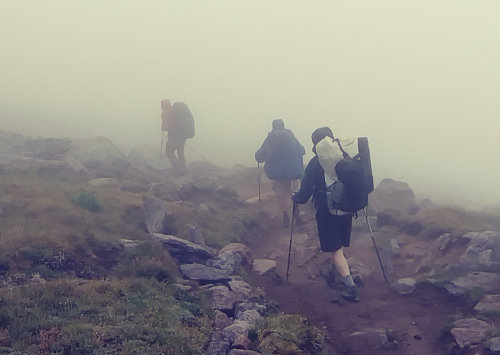
A night at the campground included a little rain and ominous clouds to start our morning hike up, up, up from 9400 feet to 11960 on the shoulder of Mt. Chevaut. The temperature was great except a bit too chilly for the top couple miles. The views were much like this until we reached the top and the clouds lifted a bit. On our way down the other side towards Valentine Lake, we saw a horse train following us, most likely with clients looking for a camping spot.

The first day's hike was pretty strenuous, so we were happy to arrive at the lake before the horses and find a great spot. When the horses came past, it was pretty evident they were intending to use this spot - whew!

Our original plan was to do a 15 mile loop over Washakie Pass and Hailey Pass. After the first day's hike, we shortened that to 12 miles and followed the South Fork of the Little Wind River to Graves Lake, then east to Moss Lake and Dutch Oven Lake. It was a good choice. The hike was wonderful and challenging over beautiful, rough terrain. The fishing was great, too. Gaves Lake has a surprise for anyone that ventures there - a long sandy beach and crystal clear water.
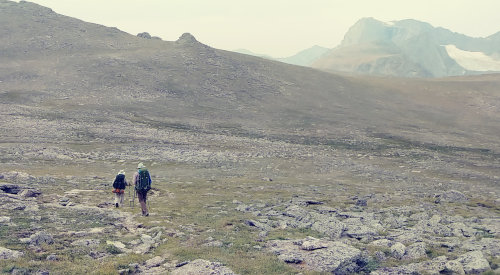
The next morning when we had to retrace our route for 3 miles so we could head south to the Cirque of the Towers. It was fine, but going over the same trail isn't too exciting. When we climbed back up to 11,000 feet, we were gifted with a long, fairly flat walk across a couple miles of tundra plateau. It was very cool and I was thankful that the weather was perfect - lightning up here would be concerning.

After traversing the plateau, we took a very nice, long rest break high on the steep hillside overlooking Lizard Head Meadows, Lizard Head (to the right), and the Cirque of the Towers in the distance. It was just a wonderful place to sit back and soak in the wilderness.
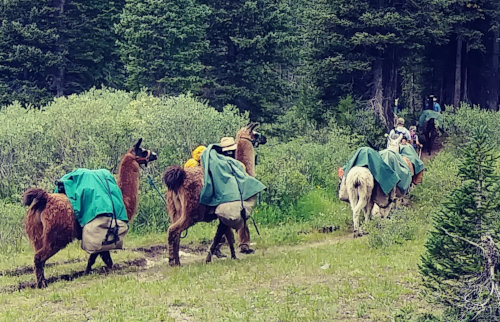
Again, we found a great campsite in the trees and set up. In the early evening, a llama train walked past. I did a little fishing and there were a few sprinkles of rain.
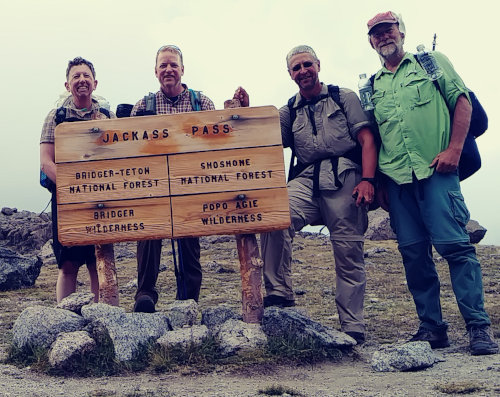
Our fourth day of hiking had us climb out of the Cirque over Jackass Pass and the Continental Divide. On the way up the climb, we crossed paths with a spread out group of macaroons with 8 or 9 dogs off leash and completely unwilling to take responsibility of controlling their animals. Another hiker that had his dog on a leash just ahead of us had three separate instances of their dogs attacking his dog. It was the worst behavior I recall ever experiencing on trail.

The hike was great and dropping into the Big Sandy drainage put us in our fourth basin. As expected, there were dozens and dozens of people on the trail and camping around the area. For one last time, we managed to locate a splendid spot to call home another couple nights. We did get hit with a short, intense rain, but everything dried out just fine.
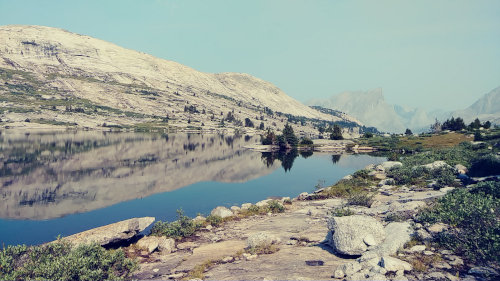
For our last full day, we did a loop hike up through Clear, Deep, Temple, Miller, and Rapid lakes. It took all day, stopping to fish at each one, and we caught fish every place we stopped. The weather was perfect all day long and we saw only a couple other people.

The most wonderful nature part of this trip, in my mind, was the hike between Clear Lake and Deep Lake. The path followed occasional cairns over solid bedrock for a half mile or so. The stream itself just ran over the rock with no real path cut into it yet. Hikers are pretty much free to map their own way up the broad, smooth rock face. Very cool!
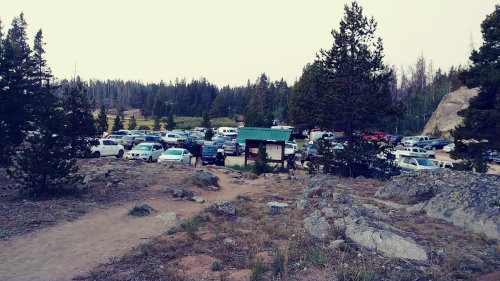
Our last day was a nice, lesisurely 7 mile hike down the Big Sandy valley to the extremely popular trailhead. The trail was cleared of hundreds of down trees, the tread was well used, the weather was most excellent, and it was almost all downhill. A great way to end our trek, passing over 60 people heading up into the mountains. Finally, after six days in the mountains, covering about 55 miles, we saw a moose! - walking through the trailhead parking lot packed with almost 200 cars. Imagine that!
We met our shuttle back to Lander, retrieved the vehicle from the Dickinson trailhead, and drove through the night to reach home around 7am. I got the midnight to 3am driving shift - an hour rain storm and two 12-mile construction zones made it a bit more exciting.
If you fish in Wyoming mountains, I would highly recommend using 'Little Jake' spinners or any terrestrial dry fly, such as grasshopper or ant. I wore out three flies and only lost one in a pine tree. I'd also recommend you remove hook barbs to reduce injury to the dozens of fish you'll catch and release.
07/25/2021
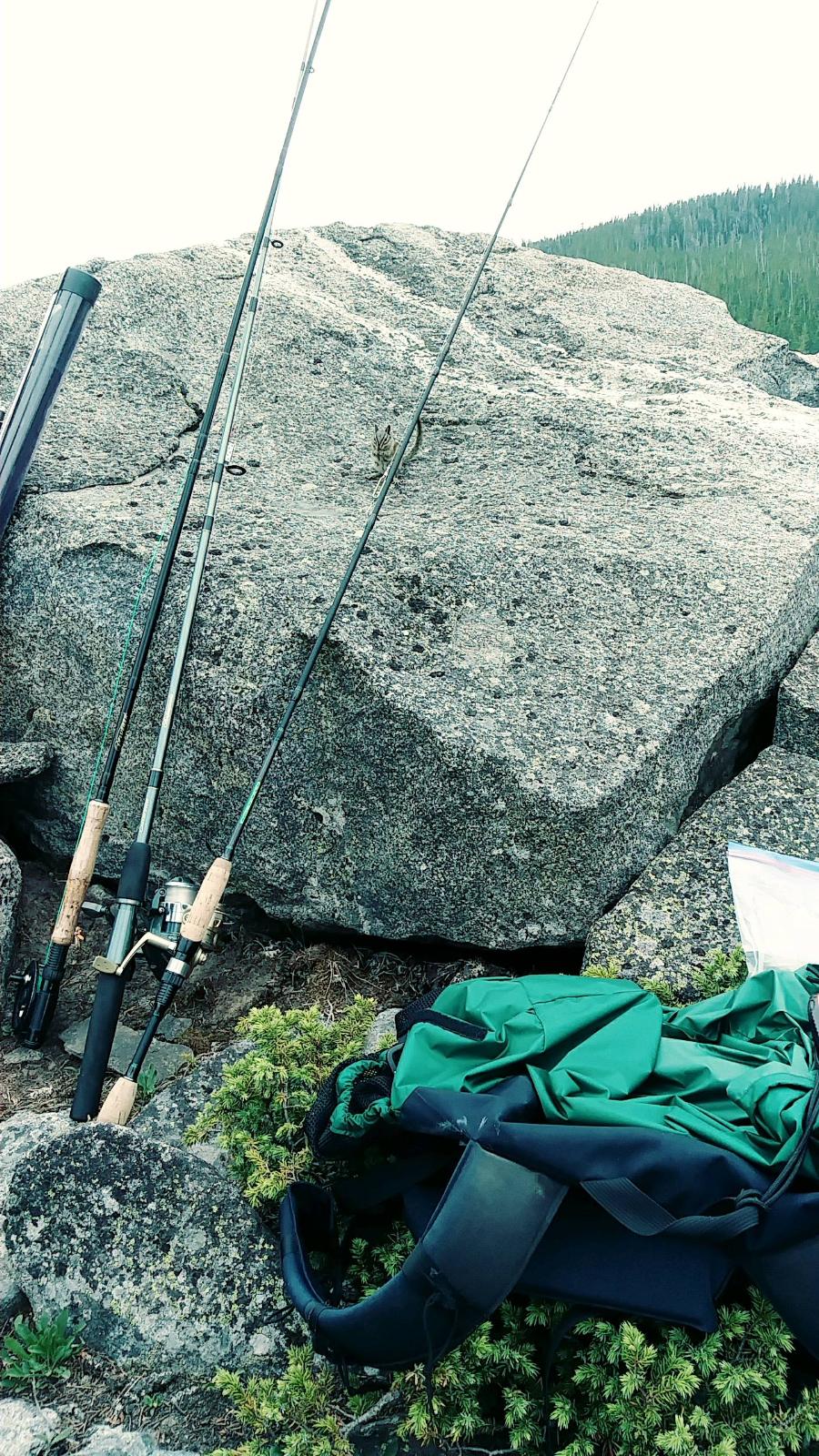 Yeehaa ! !
On the way to the horse trailhead this morning. We met our trail guides last night and dropped off all our gear for the mules to carry up the mountain for us. Now, 9 of us get to play 'city slickers' today and ride nose to butt up the trail for 5 hours to some top secret lakes packed with huge trout.
Last time I was on a horse was 2008 at Philmont scout ranch so this should be fun! Plenty of hiking between lakes for the next few days.
Yeehaa ! !
On the way to the horse trailhead this morning. We met our trail guides last night and dropped off all our gear for the mules to carry up the mountain for us. Now, 9 of us get to play 'city slickers' today and ride nose to butt up the trail for 5 hours to some top secret lakes packed with huge trout.
Last time I was on a horse was 2008 at Philmont scout ranch so this should be fun! Plenty of hiking between lakes for the next few days.Posted: 07/25/2021
Older Posts Newer Posts
Find more Hiking Resources at www.HikingDude.com


Follow Me
Recent Comments